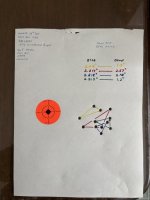Finally today a first visit to my range this year.
I did my very first powder re-load back in December, but unfortunately the weather didn't cooperate.
In meantime also I collected my full set of Wilson tools I may need for any sort of scenarios I have learned along the way of re-loading diy.
Lapua W308 brass (inherited, history unknown), powder Varget, bullet 155gn Sierra Match 2155, seating depth 0.033".
I had five batches of powder in increments from 46gn to 46.8gn to test 5 shot groups each. Testing @ 300 Meters, 17C, 33% hum, 1006.8mb.
#1 group of 5 - 46.0gn - Av 2994 fps
#2 group of 5 - 46.2gn - Av 2997 fps this group seem to me the tightest, 1.1" width and 1.5" height elongated in 45 deg to Right side.
#3 group of 5 - 46.4gn - Av 3017 fps
#4 group of 5 - 46.6gn - Av 3013 fps
#5 group of 5 - 46.8gn - Av 3051 fps
Me personally I don't like to see these high speeds, I may create in the future couple batches less powder sub 40gn and re-test for groups.
The next step I will do bullet seating in increments, probably start from current 0.033 and going up and down several steps in 0.003"
My Question is:
All what I have seen pictures online and forums - people testing seating depth @ 100M/y and usually three shots?
Why 100? Why not 200 or 300?
Any valid reason? I am just trying to learn how to read ...
I did my very first powder re-load back in December, but unfortunately the weather didn't cooperate.
In meantime also I collected my full set of Wilson tools I may need for any sort of scenarios I have learned along the way of re-loading diy.
Lapua W308 brass (inherited, history unknown), powder Varget, bullet 155gn Sierra Match 2155, seating depth 0.033".
I had five batches of powder in increments from 46gn to 46.8gn to test 5 shot groups each. Testing @ 300 Meters, 17C, 33% hum, 1006.8mb.
#1 group of 5 - 46.0gn - Av 2994 fps
#2 group of 5 - 46.2gn - Av 2997 fps this group seem to me the tightest, 1.1" width and 1.5" height elongated in 45 deg to Right side.
#3 group of 5 - 46.4gn - Av 3017 fps
#4 group of 5 - 46.6gn - Av 3013 fps
#5 group of 5 - 46.8gn - Av 3051 fps
Me personally I don't like to see these high speeds, I may create in the future couple batches less powder sub 40gn and re-test for groups.
The next step I will do bullet seating in increments, probably start from current 0.033 and going up and down several steps in 0.003"
My Question is:
All what I have seen pictures online and forums - people testing seating depth @ 100M/y and usually three shots?
Why 100? Why not 200 or 300?
Any valid reason? I am just trying to learn how to read ...
Last edited:









































































